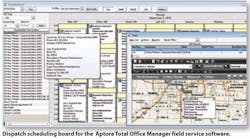The HVAC industry's use of advanced field communications technology has skyrocketed in just a few short years. That growth has been nurtured by software's ability to interact with the many mobile devices now used by more technicians, and by software's convenience and efficiency.
One of the customer service functions most enhanced by these software innovations, is the place where it all begins: in the dispatching zone.
The days of radio-only communications are disappearing, and "Mr. HVAC," James Leichter, president, Aptora Corp., Lenexa, KS, couldn't be happier about that. Leichter, who has worked as a field technician and business owner, says dispatching software eliminates everything that's wrong with radios: from garbled communications, to writing down notes on reams of paper, and a potentially less safe procedure for a technician driving a vehicle.
Dispatching software, Leichter says, has helped improve HVAC customer service in four dispatch-related areas: the dispatch itself, the arrival at the home, the invoicing, and the communication of the day's business to the business owner.
"The process of having the dispatcher immediately see who's available for the call, and handing it off to them on a screen, is much more efficient," Leichter says.
"Once the technician arrives at the home, they've already seen much more information than they ever had before about the customer, such as what type of air filter size they need, and service history. The technician arrives at the home more informed, and more empowered to make better service decisions," Leichter says.
Aptora's Total Office Manager® field service software was written by actual contractors. Its features include complete accounting, customer relationship management, dispatching, inventory control, mobile field service management, and more, in one service management software program for more efficient service business management.
Goin' Mobile at a Swift Pace
"The best field service programs now make it easy and affordable to provide online communication between the office, field technicians, and customers," says Daniel Restivo, CEO, Intac International, Inc., Burlington,MA, makers of Wintac™ business automation software.
"Five years ago, less than half of our customers used the mobile computing features of our software," Restivo reveals. "Today more than 90% of them communicate job information between the office and field with wireless. As mobile devices — such as smart phones, notebooks and tablets — become more accessible and affordable, field service companies are realizing the productivity benefits."
Restivo says contractor office support staff and field technicians can now rely more on online technology to help support the dispatching function.
"A majority of our users require that their technicians have online access to their current work orders, but also the details of each job location, including a list of installed equipment, complete service history, material and parts required for maintenance, and more," he says. "Technicians must have the capability to update any of this information remotely, as well as process credit or debit card payments online at the customer site, and allow customers to provide signatures electronically using tablets.
"With the latest innovations in dispatching software, a truly paperless operation is now a very practical reality for any size HVAC company," Restivo says.
"We couldn't live without it," says Mark Baker, president, Air Waves Heating & Air, Columbia, SC., whose company uses the Wintac product.
"I like its versatility, and the fact that we can transmit work orders and invoices from the office to the vans out in the field," Baker says. "The technicians can service customers, get signatures on invoices, and send them back to the office electronically. At the end of day, we know where every dollar went, and who owes us anything. It doesn't let any moss grow under our feet."
'Sizing Up' the Information
"Many people want software that provides full invoicing for an iphone or similar smaller device," says Nate Tuttle, president, TEAM Management Systems, Fort Myers, FL. "But, if you think about everything that's involved with a service call: viewing customer information, viewing a description of the problem, past history, equipment, which materials are used, what was done to solve the problem, generate an invoice, capture signature and print out a receipt — think about doing that on a two-inch screen. With the smart phones, there isn't enough screen space. The alternative is to have an ipad or tablet version. The technician can download the information/invoice. Our system looks like a generic paper workorder."
Team Management Systems' Mobile Work Order not only looks like a standard paper work order, but also works like one. The technician simply enters dispatch times, material used, equipment serviced, and what was done to resolve the problem on one easy-to-navigate screen. A copy of the signed invoice can be printed for the customer, and all of the information is downloaded back at the office.
BuddySmith, president, Russell's Heating & Cooling, Chesapeake, VA, uses Team Management System's ACOWIN and ACOTRUCK.
"It's a huge time saver," Smith says. "When it's busy, it's nice that the dispatchers don't have to talk the technician through every detail of the call, repeat words, or clarify spelling. They just touch a button, and the information appears on the technicians' field tablets.
"In summer, we used to get behind on paperwork. When invoices came in we'd have to find parts codes. With this, everything's coded off, and it's done."
Jonathan Frei, marketing director, dESCO, LLC, Fort Myers, FL — makers of ESC Software — agrees that dispatching makes paper a thing of the past.
"As service calls come in, they can be sent right to the mobile device, along with the customer's service history. It’s a 'real time' event.
"The real key to dESCO's dispatching software, however, is the flexibility it provides to the dispatching situation," Frei adds. "It's easy to grow into the mobile world as fleets grow. Contractors can mix and match devices. One technician might be use an ipad, another a laptop, or another an Adroid phone."
Page 2 of 2
'Leggo' My Laptop!'
Conditioned Air, Naples, FL, implemented the SAWIN mobile software by Service Automation, in November, 2007. It was a time when business service software still wasn’t a fully proven and accepted service tool.
"Our technicians thought it would cut their productivity," relates Keith Walker, chief operations officer. "They thought it was faster to use handwritten invoices. We heard that over and over during the training sessions."
Good for Conditioned Air, for going forward with the change, because today, its techs are crazy about computers.
"About one month later, you couldn't pull those computers away from them," Walker recalls. "I've heard that over and over again from other people in our industry. It takes only about a good month for them to get used to it, adapt to it, and fall in love with it."
Walker says the biggest benefit of using SAWIN is improved efficiency, and that about says it all.
"It improves the efficiency of our communication exchange," he says. "The technician has access to service history. He or she can see the last 20 calls performed on the customer's equipment. As they approach the home, they know what they’re dealing with."
Additionally, says Walker, streamlined communications allow Conditioned Air to grow its service department as needed, without adding much office overhead.
"We would never be able to have two people handle the billing for 40 technicians without it," he says.
Tracking the Stats
Kathy Everett, president, Colony Air Conditioning & Heating, The Colony, TX, has been using Successware™21 software for well over a year. She likes the fact that it automatically tracks an array of performance statistics for technicians — such as number of tasks per call, average ticket amount, time spent on the job (to crosscheck with flat rate task times), leads generated, service agreements sold, and more.
"This makes it extremely easy for the dispatcher to generate daily, weekly, and monthly reports," Everett says, and provides management with hard facts for coaching purposes, goal setting, finding areas that need improvement, and more."
For easier communication between dispatch and the field, the dispatch board is color-coordinated for user-defined geographical areas, to route technicians most advantageously, for faster customer service and less technician windshield time.
"The estimated length of each call is easily displayed to help dispatcher scheduling," Everett explains. "Icons appear for each service call, to indicate the progress of the call, late arrival alerts, parts to be ordered, and more. Our dispatcher has every imaginable piece of information about the customer at his fingertips."
Everett says the Successware 21 software has helped Colony increase its number of daily service calls.
"Ours increased about one call per day, per technician," she claims. "When you multiply that by the average ticket amount — which is generated automatically by the software — you can easily calculate the additional dollar amount generated. The amount is staggering."
Style Points
Software is indeed a boon to the dispatching world, but it can only be as good as the team that puts it to work. Style — or, grace under fire, if you will — is everything in dispatching. It affects how your customers perceive your organization's efficiency, the dispatchers' relationships with the field technicians, and the technicians' ability to perform their jobs like real pros.
"We're not allowed to let the phone ring more than three times, and we have a template for answering: 'Hello, my name is X, thank you for calling Climate-Tech. How may I help you?' says John Dubecky, president of Climate- Tech, Inc., North Ridgeville, OH. Dubecky insists that while his Wintac software handles his dispatching, customer service must be at "the center of the target," at all times.
Dubecky three technicians handle more than 1,200 service agreement customers.
"Nothing else is as important as direct customer service. We move out from there, to service agreements, and demand service and sales. We make sure the customer is attended to. Their time is more important than ours," he says.
"Follow the procedures that we have developed over the years, and the big problems never happen."
Dubecky's philosophy works. In mid-March, the company had exceeded its first quarter sales target by 53%, and the company has been named to the Angie's List Super Service rankings for 12 straight years.
Kathy Everett believes a quality dispatching system can reduce complaints from customers, and technicians.
"Happier customers and happier techs are the name of the game," she says. "With fewer complaints, the dispatcher has fewer fires to put out, which keeps him out of the proverbial 'pressure-cooker,' she says. "With less stress all around, the workplace can actually become satisfying instead of chaotic."
Supplemental Smarts
Many companies erroneously believe saving fuel and technician travel time is the important goal of the dispatch system. A dispatch system can help dispatchers and the company become more efficient, but that's simplistic, and overlooks the big opportunities. Companies will only get the big returns on their dispatch system when they also implement the associated dispatcher and technician business processes.
Implementing these best practices will ensure that the right technician is dispatched to the right job, that the technician is well-prepared to meet the customer, that the customer will receive the best possible information, service, and choices, that the technician is debriefed appropriately, and all follow up information is recorded appropriately.
The software vendor, a best practices group, or a contractor alliance will be able to provide these best practice business processes.
— David Heimer, chief operations officer, Service Roundtable
In-house Product 'Escalates' Efficiency for Commercial Contractor
Engineering Excellence, Inc., Cincinnati, OH — the 2005 ContractingBusiness.com Commercial Contractor of the Year — uses a dispatching program its team developed in-house. It includes "escalations" related to service urgency. These are computer-generated reports that "pop out" for management to see.
"One of the keys to success driving maintenance programs is to get things done on time. To us, that's a 30- to 45-day window," says Tom Winstel, Jr., president/chief operating officer. If maintenance for a customer is approaching the end of that period, the escalation warning ensures a timely completion of that call.
"These reminders are escalated to various people besides the dispatcher, just to ensure quality control. And that has made a big difference for us," he says.
Engineering Excellence also performs real-time tracking of service calls for about 70 technicians who service customers in Columbus and Cincinnati, OH, and Northern Kentucky.
"Our customers can actually email us a service call, and it shows up on the working dispatch board," Winstel explains. "It allows the dispatcher to dispatch the technician without any communication with the client."
Winstel believes wireless hand-held devices will increase in popuarity over the next five years.
"That will drive a total change in our business," he says. "The dispatcher will not be communicating directly to the technicians. It will all be pushed out to a wireless device. We're not there yet, but I know a lot of companies are."
Winstel believes the "dispatcher of the future" will have a different role to play.
"Dispatchers will be handling more techs, and their roles will change. Much of their time won't be spent on the phone, which frees them up to do other things, like client service activities," he says.
"They'll still be managing a dispatch board, but instead of talking with the technician, the technician will be able to have their hand held device tell them everything." — TM









